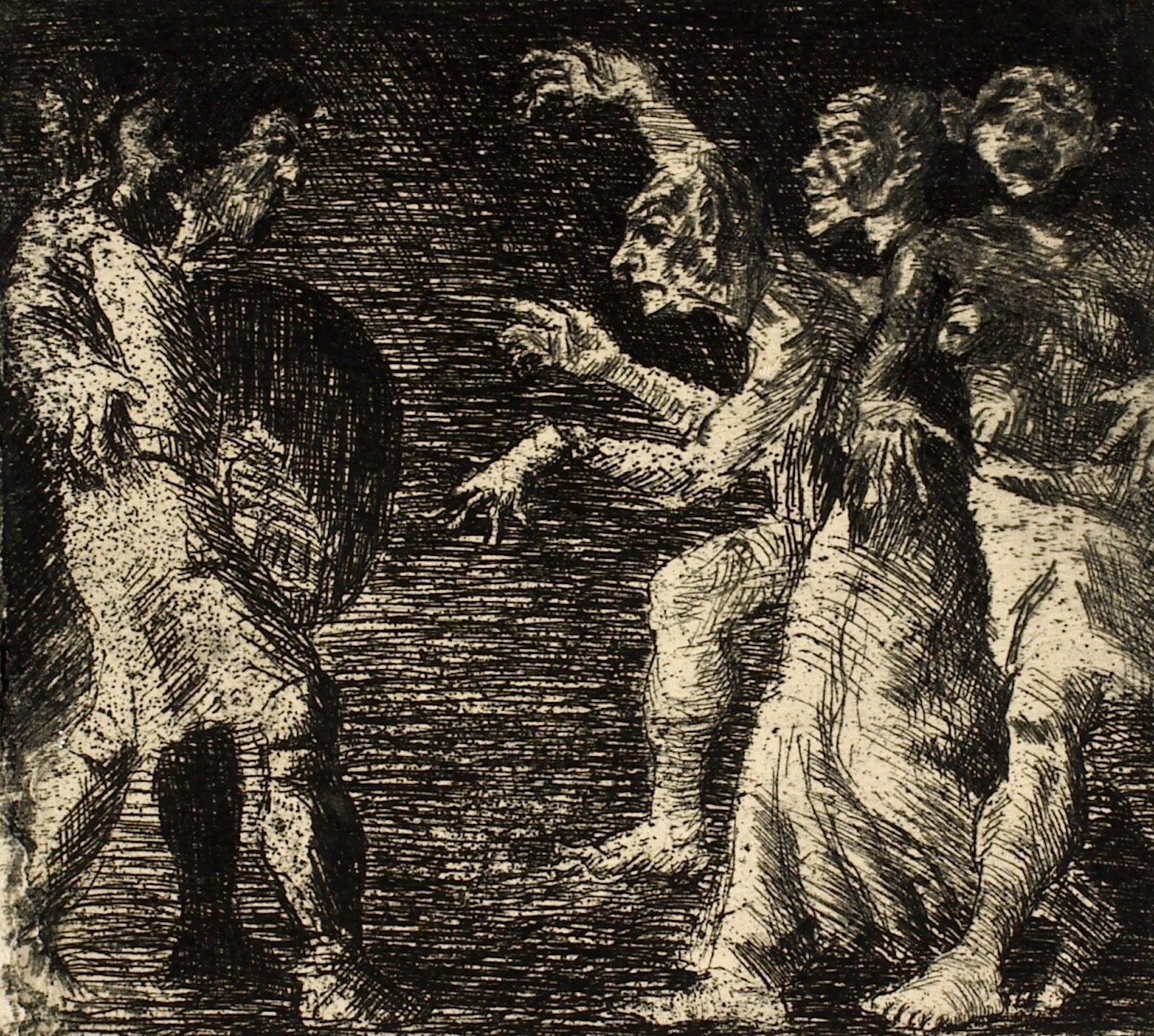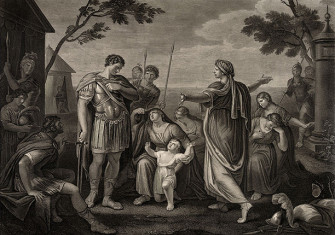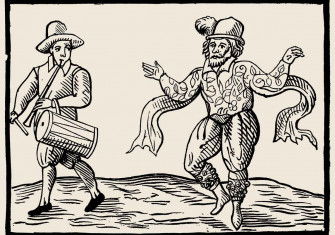The Real Macbeth: King of Scots, 1040-1054
A study of the hostile legends, immortalized in Shakespeare’s tragic drama, that have gathered around the real historical figure of Macbeth.

Shakespeare’s Macbeth, king of scots, was a real person; and the historical facts concerning him, as they are given by writers at all close to his lifetime, may be quickly told. He was the dux (or general) of King Duncan, whom he killed—probably somewhere in Moray—in 1040. He succeeded to the throne, ruled for fourteen years, resisted at least one English attack, and in 1050 visited Rome on pilgrimage. In 1054 he was defeated in battle by Siward, the Anglo-Danish Earl of Northumbria, who installed Malcolm, son of Macbeth’s predecessor, as king. Three years later Malcolm defeated and killed Macbeth at Lumphanan in Aberdeenshire; the dead king was buried, as was Duncan before him, in St. Columba’s island of Iona.
With these few facts the historian has to do two things. The first—to place Macbeth in his historical context—is perhaps the easier. It seems clear that he was both a member of the royal house of the Scots, descended from Kenneth MacAlpin, who first united Picts and Scots into a single kingdom in the ninth century, and a leader of the rival house of the rulers of Moray, long a thorn in the flesh of the Scots kings. Macbeth’s mother was a sister of the powerful King Malcolm II, who in 1018 defeated the men of Northumbria at Carham and confirmed Scotland’s possession of the Lothians; Duncan was actually a grandson of the same Malcolm, and so Macbeth’s blood-relative, but of a younger generation. Macbeth’s father, Findlaech, was maormaer (provincial ruler, or sub-king) of Moray, and was called by some writers King of Scotland—a reminder of older days, when kings were as common in Scotland as in Ireland, and a united kingdom had not yet been created. Shakespeare’s Lady Macbeth, in real life, was called Gruoch, and was the widow of Macbeth’s cousin Gillacomgain, another ruler of Moray; her son Lulach, called by some writers “the Simpleton,” tried unsuccessfully to carry on the opposition to Malcolm after his stepfather’s death.
In an age of few written records, of bitter family feuds, and of a kingdom slowly emerging from tribal mists, it is hardly surprising that this story of Duncan, of Macbeth the supplanter, and of Malcolm the avenger, should look like nothing more than a half-remembered tale of vendetta and savagery. Such it undoubtedly was. Yet there is a little more that can be said about it. For Macbeth was a good king—a better one than the man he killed— and he stood for a certain tradition in government, and in cultural and racial outlook, which was shortly to be cut drastically short, through the work of that Malcolm “Ceann-mor” (or “big-head”) who supplanted him. In retrospect, the historian can see that something momentous happened when an English army set upon the throne of Scotland a man who had spent fourteen long years in exile in the kingdom of Edward the Confessor.
The construction of the kingdom of Scotland was a slow business, far from finished in 1040. It had begun with Kenneth MacAlpin, ruler of the tribe of Scots in Argyllshire, who had taken advantage of the confusion of the Viking Age to overrun the mysterious Picts of central and northern Scotland—a people whose origins and language still puzzle the historian. By the 11th century his descendants had pushed their frontier far to the south of the Forth, the ancient southern boundary of Pictland. The Welsh-British principality of Strathclyde and Cumbria was in their hands; Malcolm Ceann-mor was Prince of Cumbria in his father’s lifetime. In the east the English settlers between Forth and Tweed acknowledged Scots supremacy.
To the north, however, progress was less obvious. Ancient Pictland had been divided into a number of separate provinces, of which two—Moray and Caithness—lay beyond the barrier of the Grampians (the ancient “Mounth,” or sometimes “the spine of Alban”), which long formed an obstacle to peaceful government, if not to armies. It was from the recalcitrance of the Picts of Moray that the chief difficulties of the Scots kings arose. Moray was remote and isolated, it had its own royal house, and it went very much its own way. To the north there was nothing but Caithness, in the 11th century largely in the hands of Norse colonists from the Orkneys (at this time, and until the 15th century, a dependency of Norway). The Orkney Saga, which gathers the legends and recollections of the Viking settlers from their first arrival in the ninth century, shows that the rulers of Orkney had ambitions across the Moray Firth. Jarl Thorfinn the Mighty, whose father died in the battle of Clontarf in Ireland in 1014, raided far into Scotland, and at one moment seems to have had most of the north in his hands. He was, in fact if not in name, the equal of the King of Scots, and as dangerous an opponent as the maormaer of Moray; Malcolm Ceann-mor found it politic to marry his daughter. Against two such opponents, the kings of the line of Kenneth MacAlpin could do little outside the limits of their own immediate dominions.
Macbeth was the last ruler of Moray who was able to snatch the crown of all Scotland. Even in his own reign the shadow of the future appeared. One chronicler tells us that when, on the Day of the Seven Sleepers (July 27th, 1054), Siward of Northumbria brought back the exiled Malcolm and destroyed Macbeth’s army, there perished not only many thousands of Scots but also “all the Northmen.” These “Northmen” were a band of mercenary Normans from France, originally settled in Herefordshire under the auspices of the half-Norman Edward the Confessor; expelled in an anti-foreign reaction, they had followed their fortune to Scotland. Ironically, it was the man who most benefited from their destruction, Malcolm, who started their fellow-countrymen on a conquest of Scotland which was to be less dramatic than their conquest of England, but almost as decisive. He himself, after the death of Thorfinn’s daughter Ingibiorg, married Margaret, sister of the heir of the old Saxon royal house, and so involved himself inextricably in the policies of the Saxons’ successor, William the Conqueror. His own sons held lands in England, frequented the Anglo-Norman court, and lived the lives of Anglo-Norman nobles. They resisted the efforts of their uncle, Donald Ban (or “fair”)—the Donalbain of Shakespeare—to return to the traditions of the old Celtic monarchy. The last and greatest of them, David I (1124-1153), decisively changed the history of Scotland, and the traditional view which sees him as the creator of a feudal, Norman-type monarchy and church is not very wide of the mark.
In the process the independence of Moray went under. The turning-point came in 1130. In that year, Angus, ruler of Moray and great-grandson of Macbeth’s wife, was defeated at Stracathro near Brechin, and died in the battle. It was the last attempt to reverse a process which had been gathering momentum for three-quarters of a century. The last leader of the men of Moray known to us by name was Angus’ companion, Malcolm MacHeth, who was captured four years later, and spent two decades in prison. When he emerged a new aristocracy, entrenched in castle and cathedral, was in charge of Moray. King David himself went to the province—still separate enough to be distinguished from Scotland in one of his charters—and there installed new men to maintain his control. We know something of the most important of them, Freskyn of Moray, who was possibly a Flemish immigrant, and became a landholder in West Lothian and the builder of the castle of Duffus near Elgin. Not far from Duffus is Pitgaveny, the traditional place of Duncan’s death, and together they may stand for the greatest change in all Scottish history before the eighteenth century. As for the men of Moray, a legend of considerable age holds that they fled far from the reach of David and his knights, into the remote “rough quarter” of the north-west around Cape Wrath, to become the ancestors of the later Clan Mackay. But history does not follow them there, and indeed we know little of Scotland’s farthest frontier before the sixteenth century.
The second task is a more complex one. How can we relate the eleventh century to the sixteenth? Out of all that we have examined, what can we find of Shakespeare? A king called Duncan and another called Macbeth, a prince called Malcolm and another called Donalbain, and an earl called Siward—these are people who existed, whose names survive in contemporary record. Macduff of Fife hovers uncertainly on the edge of historical reality, vouched for by an oblique reference in a single dubious land-charter. Banquo is unknown to the historian, and we know nothing that would lead us to tax Gruoch with the deeds of a Lady Macbeth. Beyond that, the facts are only what we have seen—with one curious little addition. Old Siward’s reply, when told of his son’s death, is well known; but it is not Shakespeare’s invention. The story is first told by Henry of Huntingdon, who wrote within a century of the event: “And when they told his father that he had been slain in battle Siward said: ‘Did he have the mortal wound in front of his body, or behind?’ The messengers said: ‘In front.’ And Siward replied: ‘I rejoice, for I would hold myself or my son worthy of no meaner death.”
This detail contains a clue for us, and we can try to follow it. Macbeth has much in common with Shakespeare’s historical plays. For instance, it shares a source-book with them, from which detail of this kind might be drawn. This is Raphael Holinshed’s collection of Chronicles, published in 1577. In the medieval tradition, Holinshed drew largely upon previous writers, and in the case of Macbeth we can trace his story—which is basically Shakespeare’s—back to a point some two centuries earlier, but still three hundred years after the events which it purports to describe. There the trail fades out, and we are left with only the earlier, simpler story.
This suggests rather forcibly that one of two things happened: either a creative imagination, or imaginations, had been to work on the written records, or the centuries had worked a slow change in a dimly-recollected tale. The difficulty of deciding between the two is perhaps more apparent than real. There are reasons for suspecting that both happened. On the one hand, there is the fact that the first version of the embroidered tale comes from John of Fordun’s Scotichronicon. John was the first of “scientific” Scots historians, the first writer with the historical curiosity and literary skill equal to the task of gathering together all the available evidence of Scottish history before his time—he wrote probably in the 1380s— and of weaving it into a narrative story. On the other hand, there is the evidence of Prior Andrew of Wyntoun’s verse Orygynale Cronykil, the first vernacular history of Scotland, which appeared some forty years after the Scotichronicon.
John of Fordun’s story contains the murder of Duncan, the flight of Malcolm to England and of Donalbain to the Isles, and the expulsion of Macduff of Fife. It has nothing to say of Lady Macbeth, nor of the weird sisters; but it includes—in a passage much ornamented by parallels from classical and early medieval history—the story of Macduff’s attempts to persuade Malcolm to return to Scotland, and of the latter’s objections. It concludes with the expedition of Malcolm and Siward, and the retreat of Macbeth to the north, where he is overtaken by Malcolm, and defeated and killed at Lumphanan. There is a good deal in the version which is obviously taken from earlier writers; in fact, the only serious addition to the story is Macduff. John was a careful writer, not above pointing a moral or adorning a tale with polite learning, but he had some of the instincts of an historian, and a gift for the construction of a plausible narrative.
Andrew of Wyntoun’s verses have a wilder ring. Lady Macbeth is still absent; but the three weird sisters appear, and their prophecy to Macbeth, cast in the form of a dream. Macbeth himself is the villain—explained by the fact that he is the Devil’s son. He builds a great house on Dunsinane Hill near Perth, quarrels with Macduff, and drives him to England. There—as in Fordun’s story—Macduff reasons with Malcolm, who in the end consents to return to Scotland. The expedition follows, with two significant additions: the episode of the moving wood of “Brynnane,” and that of the killing of Macbeth, who has fled over the Mounth to Lumphanan, by a nameless knight who “wes nevyr borne.”
Already here are the essentials of the story which Shakespeare was to transmute. Only Lady Macbeth and Banquo are lacking; and we can show something of their appearance too. The first hint is in the history—which has a well-deserved reputation for mendacity and invention—of Hector Boece, Principal of King’s College, Aberdeen, rather less than a century after Wyntoun. Boece’s translator, John Bellenden, developed the hint; the version in Holinshed amplified it; and Shakespeare did the rest.
What cannot be shown, however, are the tantalizing stages between the 11th century and the 14th. A comparison of Fordun and Wyntoun suggests that the former was the better historian, but the more likely to rationalize his evidence. The story of the “temptations” —the word is Fordun’s—of Malcolm is a suspicious one, and has the stamp of intelligent invention. On the other hand, the passages that first appear in Wyntoun look much more like folk tales, with a magical quality about them. We should feel happier about them if we could point to documentary evidence for them nearer to Macbeth’s own time; but they may well be evidence that the Macbeth who passed down into popular memory was substantially the Macbeth of the play.
Can we suggest that contemporaries looked at him in this way? The argument must be one from silence; but certainly no writer of the age conveys any impression of moral condemnation. The records of Duncan’s death are noncommittal, whereas one source at least states that Malcolm himself defeated and killed Lulach by treachery. There are, moreover, other cases in which the same writers can show indignation. The great case of treachery, to which they give much attention, is that of the murder of Kenneth II, Macbeth’s grandfather, in 995, through the scheming of one Finella, whom all the chroniclers name and condemn; Fordun himself later wrote eloquently on the episode. But Macbeth has no such reputation and, according even to Wyntoun, governed well. We may perhaps surmise that Malcolm’s return was more a matter of English intervention than the patriotic Fordun was prepared to admit.
Why, then, did the hostile legends gather round Macbeth, and why was Duncan transformed from the man “of immature age” of one 11th century source into a venerable and gracious ruler? The darkness of the authorities forbids a complete answer; but it is possible to make a guess as to part of the process. In 1235 King Alexander II, Duncan’s great-great-great-grandson, endowed a chaplainry in the cathedral of Moray at Elgin, where a chaplain was to say mass for the soul of his ancestor, and to receive 3 marks (£2) out of the royal revenues for the service; two centuries and more later the 3 marks were still being paid. Now, a single piece of evidence is a flimsy basis for any theory; but it may have its significance when placed beside the “line” on Macbeth and his times that came down to Fordun and Wyntoun. For we must remember that Macbeth was a man of Moray, and that Moray remained the great danger to the Normanizing, Anglicizing house of Malcolm Ceann-mor for almost a century after his death. It would have been surprising if memory had not, among the new ruling aristocracy, come to tinge the story of Duncan with a tragic colour which contemporaries had not seen, if it had not projected on to the greatest maormaer of Moray something of the hatred and fear which the stubborn Celtic rearguard inspired.
The tragedy of Donalbain was never written by Shakespeare; but it was close to the tragedy of the historic Macbeth. For Donald Ban was no lover of his brother’s southern ways; and he, too, tried to return to a Celtic kingship. In the end he died an old and blinded man, who had been twice King of Scots and had been twice deposed by his own nephews. He was buried in Iona of the Kings, as were Macbeth and Lulach; but neither Malcolm nor any of his children were. On the watershed of history for which that single fact may stand, we can place the tragedy of Macbeth: in the countryside over the ridge from his own life we might well—if only our landmarks were more plentiful—discover the origins of the very different person of the same name whom Shakespeare found in the pages of Holinshed.
R. J. Adam was Senior Lecturer in Medieval History at the University of St. Andrews, and author of Conquest of England: The Coming of the Normans (1965).






